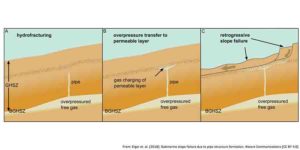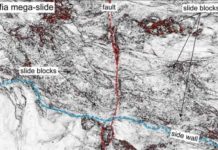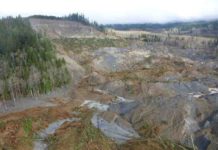
Like avalanches onshore, there are different processes that cause submarine landslides. One very widespread assumption is that they are associated with dissociating gas hydrates in the seafloor. However, scientists at GEOMAR Helmholtz Centre for Ocean Research Kiel have now found evidence that the context could be quite different. Their study has been published in Nature Communications.
In the mid-1990s, German scientists, among others, were able to prove that the continental slopes at ocean margins contain large amounts of gas hydrates. These solid, ice-like compounds of water and gas are often considered a kind of cement, which stabilizes the slopes. Since gas hydrates are only stable at high pressure and low temperature, rising water temperatures can cause gas hydrates to dissociate, or ‘melt’, in simple terms. It has been suggested previously that large-scale gas hydrate dissociation could cause submarine landslides that could in turn trigger tsunamis. The fact that many fossil landslides correlate spatially with sediments containing gas hydrates seems to strengthen this argument.
Now, researchers from GEOMAR Helmholtz Centre for Ocean Research Kiel, together with colleagues from Kiel University and the Alfred Wegener Institute Helmholtz Centre for Polar and Marine Research, have found evidence that gas hydrates and submarine landslides are indeed linked — but in a quite different way than previously thought. “Our data show that stable gas hydrates can indirectly destabilize the sediment above,” says Dr. Judith Elger from GEOMAR. She is the lead author of the study, which has been published in the international journal Nature Communications.
An inconsistency in the previous theory, which focused on melting gas hydrates as the cause of submarine landslides, was the starting point of the new research. “The water depths did not match. With rising water temperatures or decreasing sea levels, gas hydrate melting would be initiated around the upper parts of continental slopes. However, most known fossil submarine landslides were triggered in greater depths,” explains Dr. Elger.
To resolve this contradiction, the geophysicist examined seismic data from the area of the Hinlopen Slide, which occurred about 30,000 years ago north of Svalbard in 750 to 2,200 meters water depth. The team used the seismic data to simulate new processes with a computer model.
It turned out that gas hydrates can form a solid, impermeable layer beneath the seafloor. Free gas and other fluids can accumulate below this layer. Over time they create overpressure. Eventually, gas hydrates and sediments no longer withstand this elevated pore pressure and hydro fractures form in the sediments. These fractures form conduits that transfer overpressure to shallower coarse-grained sediments and thereby trigger shallow slope failure. In the case of the Hinlopen Slide, these fluid conduits are still visible in the seismic data.
“We were able to show that this process is a realistic alternative to other triggering processes for the Hinlopen Slide, and it is completely independent of climatic changes. However, important information about the properties of gas hydrate-bearing sediments is still lacking to improve our models,” says Dr. Elger.
In any case, the study shows a new causal process that has not been considered so far in the search for causes of submarine landslides. “Further studies that combine seismic data and geotechnical laboratory experiments must now show whether similar fractures can be detected beneath the seafloor on other historical landslides and whether this is a common phenomenon,§ Dr. Elger concludes.
Reference:
Judith Elger, Christian Berndt, Lars Rüpke, Sebastian Krastel, Felix Gross, Wolfram H. Geissler. Submarine slope failures due to pipe structure formation. Nature Communications, 2018; 9 (1) DOI: 10.1038/s41467-018-03176-1
Note: The above post is reprinted from materials provided by Helmholtz Centre for Ocean Research Kiel (GEOMAR).










